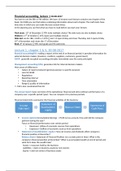Samenvatting
Summary Financial Accounting IBA year 1
All lectures from Financial Accounting of the first year from IBA (Tilburg University). The summary contains information from the lectures as well as information from the tutorials. I used different colors for different lectures which gives it a nice overview. By learning from my summary I received...
[Meer zien]






